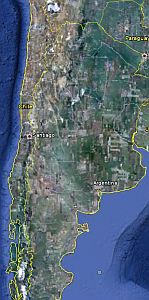
Exploring the history and experiences of mixed heritage persons and inter-racial relationships across the world

Exploring the history and experiences of mixed heritage persons and inter-racial relationships across the world
 Historians are debating whether deliberate genocide or circumstances are the reason why Argentina boasts such a small ethnic population. Both Amerindian and Afro-Argentinians make up about 5% of the population which will also explain the fairly low 8% of the population that self-report as being of Mestizo origins. Non-white Argentinians experience varying degrees of perceived racism and so this figure needs to be treated with caution as many light Mulattos (black/white mix) and Mestizos (Amerindian/white mix) pass for white or trigueño (a dark skin white person), and are careful not to associate themselves with the Afro-Argentine or the indigenous community.
Historians are debating whether deliberate genocide or circumstances are the reason why Argentina boasts such a small ethnic population. Both Amerindian and Afro-Argentinians make up about 5% of the population which will also explain the fairly low 8% of the population that self-report as being of Mestizo origins. Non-white Argentinians experience varying degrees of perceived racism and so this figure needs to be treated with caution as many light Mulattos (black/white mix) and Mestizos (Amerindian/white mix) pass for white or trigueño (a dark skin white person), and are careful not to associate themselves with the Afro-Argentine or the indigenous community.
Argentina is an immigrant country with some 85% of the population claiming European ancestry. Despite the fact it was originally a Spanish colony up to independence in 1816 and following an independence war, the Italian population in Argentina is the second largest in the world outside of Italy, after Brazil. The Italians are the largest European group, followed by the Spanish but there are sizeable other groups from France, Germany and Switzerland, Denmark, Sweden, Ireland and the United Kingdom. Additionally, Argentina's Jewish population is the fifth largest in the world. Approximately 5% of the population are Middle Eastern and East Asian from recent migrations from that part of the world and usually regarded as 'white' in Argentinian society.
Recent genetic studies reveal that the genetic average admixture of the Argentinian population contains 80 % of European contribution, 15% Amerindian and 4% African. This small African contribution is supported by the results of a census conducted in 2006 in two neighbourhoods where 5% of the population knew of African ancestry, and another 20% thought that was possible but not sure. Most of the European genetic heritage has come from the paternal (father) genetic contribution and the Amerindian coming from the maternal side - seen in the mitochondrial DNA - of present day Argentinians. This is in line the Spanish colonial practise of men taking local wives. Over the years, the Argentinian tendency to the European has meant that the physical appearance of the people lost any semblance of native or African ancestry.
Over six million European immigrants arrived in Argentina between 1857 and 1950. Whilst it is hard to quantify, the largest intermixing will be between European groups. Relatively recent inter-racial miscegenation though has occurred with the Japanese, another group of immigrants who arrived starting in the 1910s. Over 75% of the 4th Generation of Japanese-Argentines are of mixed European and Japanese descent and many of them are losing the phenotypical (physical) expression of their Japanese ancestry. In Japan, most commonly used label and preferred term of self-definition for mixed race people is 'hafu' which comes for the English word half but this does not appear to be the case in Argentina.
The next largest mixed group are the Mestizos, the descendants of Amerindians and mainly the colonial Europeans. The original Amerindian population was decimated by old world diseases and to a lesser extent wars, as happened all over the Americas. Today, only 1.6% of Argentinians self-identify as indigenous, so from the outside, it would appear that the group is self-sustaining their numbers by inter-marrying. Additionally it is likely that the offspring of a Mestizo and any other racial group maybe self-identifying as Mestizo as well. However, many of those who are light enough have a tendency to pass as white.
The Argentinian obsession with being a European nation may be attributed to the policy of Blanqueamiento ("white-washing") advanced by President Domingo Sarmiento in the 1870s. It serves as the reason why most Argentinians have all but lost any physical resemblance to their non-European ancestry and is also the basis for the argument for genocide being advanced by some historians for the small black population despite the fact that slaves made up to a third of the population in colonial times.
Buenos Aires, the capital, was one of South America's major slave trading ports and a 1778 census showed very high concentration of Africans in provinces where agricultural production was greatest from 64% in the Tucuman Province and between 40% and 50% in Santiago del Estero, Catamarca, Salta and Córdoba provinces. Urban slaves were not unknown and Buenos Aires had a sizeable slave population mainly making handicrafts for sale and housed in the neighbourhoods of San Telmo and Montserrat also known as Barrio del Tambor (Drumtown). One of the slums of Corrientes, another city, is still known as Camba Cuá, from the Guarani kamba kua, meaning "cave of the Blacks". Of note, it has been documented Argentinian slaves were treated with less cruelty than elsewhere in South America.
 Early European immigration further reduced the proportion of slaves to about 15% of the population in the early 19th century. Until the abolition of slavery in 1853, owners of slaves were required to cede 40% of them for military service. Those slaves who managed a full five years of service would obtain their freedom though this did not happen much in practice. At one point the Northern Army blacks made up to 65% of the troops. The disproportionate recruitment of afro-Argentinians into the army is regarded in some quarters as a Blanqueamiento ("white-washing") strategy, a policy that has been attributed to President Domingo F. Sarmiento but must have been practised in some form prior to his term in office (1868 to 1874). Mirroring the racism of the regime of Rafael Leónidas Trujillo in the Dominican Republic, Sarmiento had a clear position on the need to eliminate Afro-Argentine component of the population.
Early European immigration further reduced the proportion of slaves to about 15% of the population in the early 19th century. Until the abolition of slavery in 1853, owners of slaves were required to cede 40% of them for military service. Those slaves who managed a full five years of service would obtain their freedom though this did not happen much in practice. At one point the Northern Army blacks made up to 65% of the troops. The disproportionate recruitment of afro-Argentinians into the army is regarded in some quarters as a Blanqueamiento ("white-washing") strategy, a policy that has been attributed to President Domingo F. Sarmiento but must have been practised in some form prior to his term in office (1868 to 1874). Mirroring the racism of the regime of Rafael Leónidas Trujillo in the Dominican Republic, Sarmiento had a clear position on the need to eliminate Afro-Argentine component of the population.
The War of the Triple Alliance military conflict was fought from 1864 to 1870 and the following War of Paraguay (1865-1870), both bloody conflicts with high body counts, decimated the black male population. Back at home, the cholera epidemics in 1861 and 1864 and the yellow fever epidemic in Buenos Aires (1871) obviously adversely affected the blacks and it is debatable that the racist government attempted any easing of the death toll. The black women who survived may have very little choice but to find non-black mates. The resultant Mulatto children would stand a better chance in white society. Today, Afro-Argentinians, mainly mulattoes and immigrants from Cape Verde make up only 4% of the population.
Apart from Cape Verde immigrants, today there are numerous immigrants from neighbouring countries such as the Paraguayans, Bolivians, Peruvians, and Chileans, and in lesser number Ecuadorians and Brazilians. There have been reports of discrimination to these groups unlike the Uruguayans tend not to face this discrimination due to their similarity with the Argentinians. It is probably too early to tell whether these groups are mixing or will mix with Argentinians or whether the number involved will ever be significant.
Links